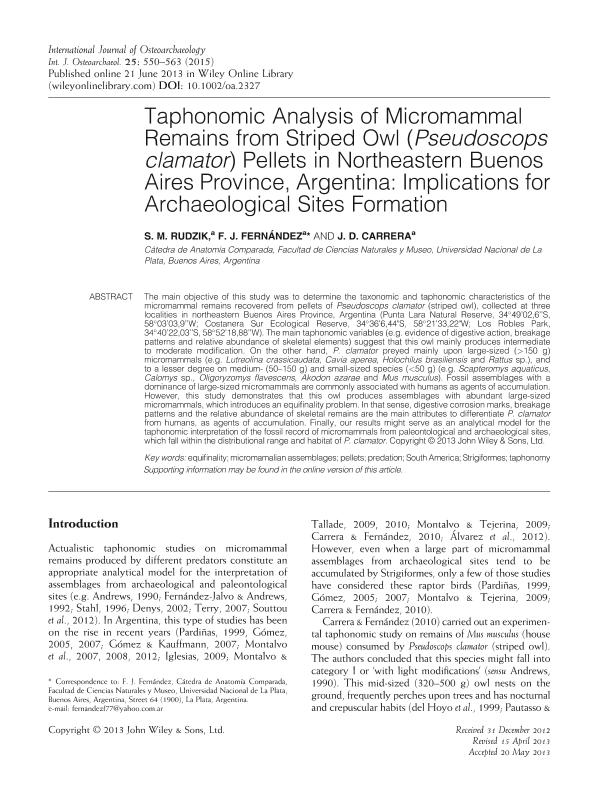Mostrar el registro sencillo del ítem
dc.contributor.author
Carrera, Joaquín Daniel

dc.contributor.author
Rudzik, Martín
dc.contributor.author
Fernández, Fernando Julián

dc.date.available
2017-03-09T21:17:31Z
dc.date.issued
2015-07
dc.identifier.citation
Carrera, Joaquín Daniel; Rudzik, Martín; Fernández, Fernando Julián; Taphonomic analysis of micromammal remains from striped owl (Pseudoscops Clamator) pellets in northeastern Buenos Aires province, Argentina: implications for archaeological sites formation; Wiley; International Journal of Osteoarchaeology; 25; 4; 7-2015; 550-563
dc.identifier.issn
1047-482X
dc.identifier.uri
http://hdl.handle.net/11336/13716
dc.description.abstract
The main objective of this study was to determine the taxonomic and taphonomic characteristics of the micromammal remains recovered from pellets of Pseudoscops clamator (striped owl), collected at three localities in northeastern Buenos Aires Province, Argentina (Punta Lara Natural Reserve, 34°49'02,6''S, 58°03'03,9''W; Costanera Sur Ecological Reserve, 34°36'6,44" S, 58°21'33,22" W; Los Robles Park, 34°40'22,03''S, 58°52'18,88''W). The main taphonomic variables (e.g. evidence of digestive action, breakage patterns and relative abundance of skeletal elements) suggest that this owl mainly produces intermediate to moderate modification. On the other hand, P. clamator preyed mainly upon large-sized (>150 g) micromammals (e.g. Lutreolina crassicaudata, Cavia aperea, Holochilus brasiliensis and Rattus sp.), and to a lesser degree on medium- (50–150 g) and small-sized species (<50 g) (e.g. Scapteromys aquaticus, Calomys sp., Oligoryzomys flavescens, Akodon azarae and Mus musculus). Fossil assemblages with a dominance of large-sized micromammals are commonly associated with humans as agents of accumulation. However, this study demonstrates that this owl produces assemblages with abundant large-sized micromammals, which introduces an equifinality problem. In that sense, digestive corrosion marks, breakage patterns and the relative abundance of skeletal remains are the main attributes to differentiate P. clamator from humans, as agents of accumulation. Finally, our results might serve as an analytical model for the taphonomic interpretation of the fossil record of micromammals from paleontological and archaeological sites, which fall within the distributional range and habitat of P. clamator.
dc.format
application/pdf
dc.language.iso
eng
dc.publisher
Wiley

dc.rights
info:eu-repo/semantics/openAccess
dc.rights.uri
https://creativecommons.org/licenses/by-nc-sa/2.5/ar/
dc.subject
Taphonomy
dc.subject
Equifinality
dc.subject
Predation
dc.subject
Micromammalian Assemblages
dc.subject
Pellets
dc.subject
Strigiformes
dc.subject
South America
dc.subject.classification
Arqueología

dc.subject.classification
Historia y Arqueología

dc.subject.classification
HUMANIDADES

dc.title
Taphonomic analysis of micromammal remains from striped owl (Pseudoscops Clamator) pellets in northeastern Buenos Aires province, Argentina: implications for archaeological sites formation
dc.type
info:eu-repo/semantics/article
dc.type
info:ar-repo/semantics/artículo
dc.type
info:eu-repo/semantics/publishedVersion
dc.date.updated
2017-03-08T15:39:56Z
dc.journal.volume
25
dc.journal.number
4
dc.journal.pagination
550-563
dc.journal.pais
Estados Unidos

dc.journal.ciudad
Hoboken
dc.description.fil
Fil: Carrera, Joaquín Daniel. Universidad Nacional de la Plata. Facultad de Cs.naturales y Museo. Laboratorio de Anatomia Comparada; Argentina. Consejo Nacional de Investigaciones Científicas y Técnicas; Argentina
dc.description.fil
Fil: Rudzik, Martín. Universidad Nacional de la Plata. Facultad de Cs.naturales y Museo. Laboratorio de Anatomia Comparada; Argentina
dc.description.fil
Fil: Fernández, Fernando Julián. Universidad Nacional de la Plata. Facultad de Cs.naturales y Museo. Laboratorio de Anatomia Comparada; Argentina. Consejo Nacional de Investigaciones Científicas y Técnicas; Argentina
dc.journal.title
International Journal of Osteoarchaeology
dc.relation.alternativeid
info:eu-repo/semantics/altIdentifier/doi/http://dx.doi.org/10.1002/oa.2327
dc.relation.alternativeid
info:eu-repo/semantics/altIdentifier/url/http://onlinelibrary.wiley.com/doi/10.1002/oa.2327/abstract
Archivos asociados
